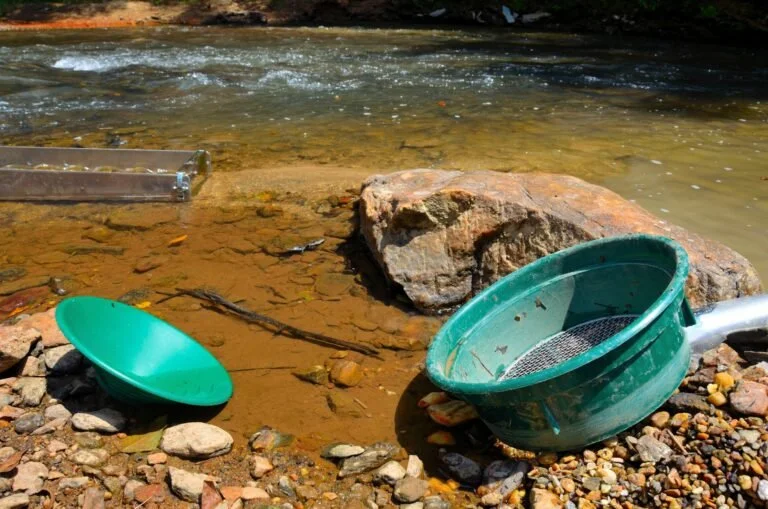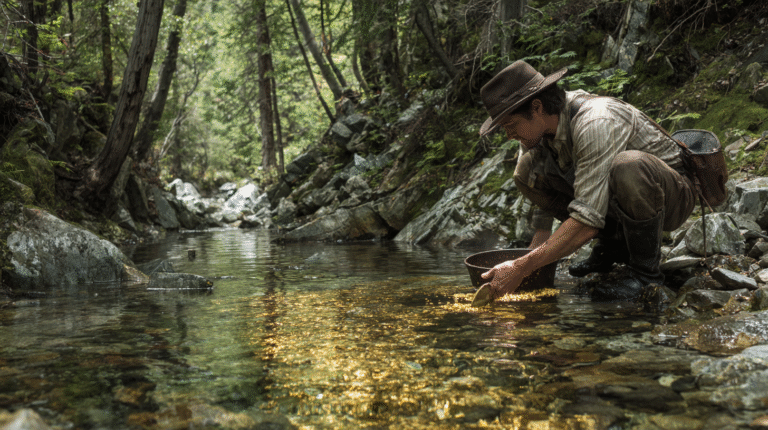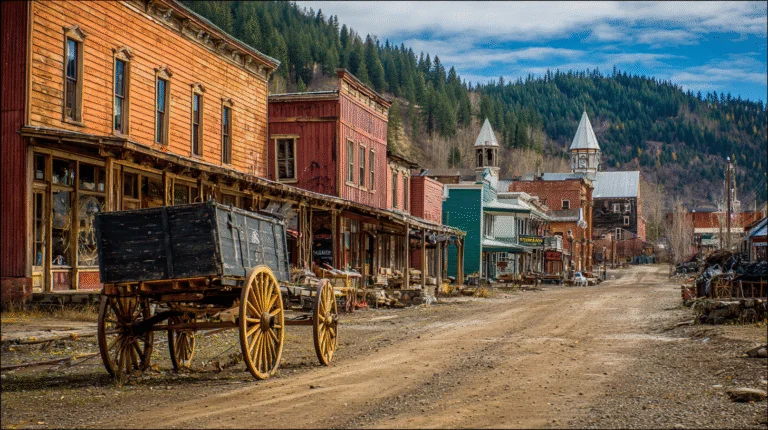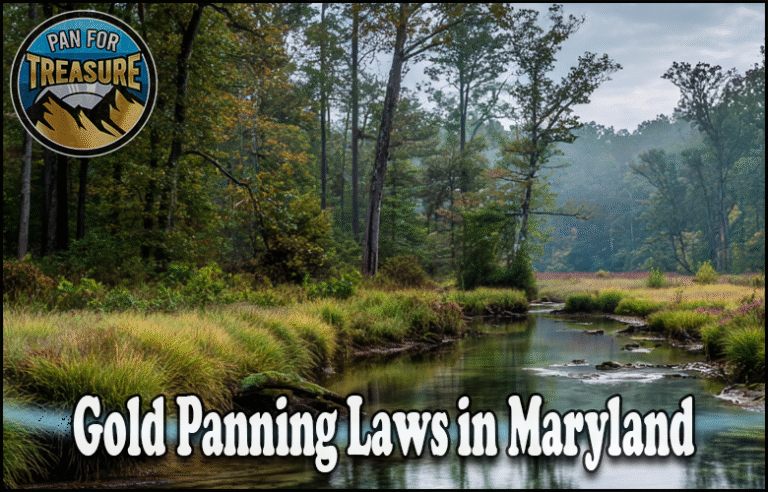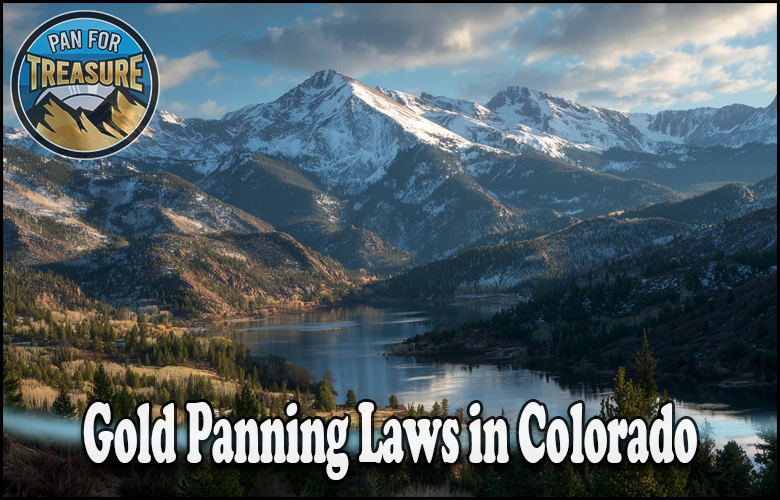
Disclosure: This Post Contains Affiliate Links; We earn a commission on purchases.
Colorado is a popular destination for gold panning enthusiasts, thanks to its rich mining history and abundant natural resources.
However, it is essential for prospectors to understand the gold panning laws and regulations in Colorado to ensure a legal and enjoyable experience.
Prospectors’ rights in Colorado are governed by specific laws that protect the environment and promote responsible mining practices.
These laws apply to both public and private lands, making it crucial for prospectors to familiarize themselves with the regulations before engaging in gold panning activities.
Gold panning regulations in Colorado encompass various aspects, including land ownership, permits, and restrictions. Understanding these regulations is essential to avoid any legal issues and to protect the environment.
In this article, we will explore the gold panning laws in Colorado and provide valuable information for prospectors. Whether you are a beginner or an experienced miner, staying informed about these laws is key to a successful gold panning adventure in Colorado.
Key Takeaways:
- Prospectors in Colorado need to adhere to specific gold panning laws to ensure a legal and enjoyable experience.
- Understanding land status is crucial, as prospecting on private lands without consent is considered trespassing.
- Recreational gold panning is generally permitted on public lands managed by the BLM or the U.S. Forest Service without a permit.
- Popular gold panning locations in Colorado include rivers like Clear Creek and the Arkansas River.
- Having the right equipment, such as gold pans and classifiers, is essential for successful gold panning.
Understanding the Land Status in Colorado
Determining the land status is a crucial part of gold prospecting in Colorado. It is important to understand the ownership and regulations regarding different types of land to ensure a legal and successful gold panning experience.
Prospecting on private lands without consent from the landowner is considered trespassing and is strictly prohibited. It is essential to respect private property rights and obtain permission from the landowner before engaging in any prospecting activities.
On the other hand, prospecting on federal lands is regulated by the Bureau of Land Management (BLM) and the U.S. Forest Service. These agencies have specific guidelines and regulations in place to protect the environment and maintain the integrity of public lands.
To prospect on federal lands, it is important to contact the relevant authorities and obtain the necessary permits. These permits may vary depending on the specific location and type of prospecting activities planned.
Understanding Land Ownership in Colorado
In Colorado, land can be privately owned or managed by federal agencies such as the BLM or the U.S. Forest Service. Private landowners have the exclusive rights to their property and can grant or deny access to prospectors.
Federal lands, on the other hand, are owned by the government and managed for various purposes, including mineral resources. Prospectors need to be aware of the different regulations and procedures when prospecting on these lands.
Federal Land Regulations and Permits
Prospecting on federal lands requires compliance with the regulations set forth by the managing agencies. The BLM and U.S. Forest Service have specific guidelines to ensure responsible prospecting and protection of natural resources.
Obtaining permits is a crucial step before prospecting on federal lands. These permits may include requirements such as site reclamation plans, limiting the use of certain equipment, and adherence to strict environmental standards.
Contacting the local BLM office or U.S. Forest Service district office is essential to understand the specific regulations and requirements for prospecting on federal lands in Colorado.
Land Ownership in Colorado
| Land Type | Description |
|---|---|
| Private Lands | Owned by individuals or companies. Prospecting requires permission from the landowner. |
| Public Lands | Managed by federal agencies such as the BLM and U.S. Forest Service. Prospecting requires permits and compliance with regulations. |
Related Gold Panning Information
Recreational Gold Panning Guidelines in Colorado
Recreational gold panning is a popular activity in Colorado, and prospectors can enjoy this pastime on public lands managed by the Bureau of Land Management (BLM) or the U.S. Forest Service. Understanding the recreational gold panning rules and regulations is important to ensure compliance and a positive experience for all.
When panning for gold on public lands, it is generally permitted without the need for a permit. However, it is crucial to adhere to the guidelines set forth by the managing authorities and be aware of any site-specific rules that may apply. These guidelines serve to protect the environment and maintain the integrity of the land. By following these rules, we can preserve the natural beauty of Colorado’s landscapes for future generations.
Restrictions on Gold Panning
While recreational gold panning is allowed, there are certain restrictions that prospectors must be aware of. The use of motorized equipment, such as suction dredges or highbankers, may require additional permits and adherence to stricter regulations. These regulations are in place to protect sensitive habitats and ensure responsible mining practices. It is important to respect these restrictions to safeguard the environment and the rights of other gold panning enthusiasts.
Respecting Private Property Rights
Another essential aspect of recreational gold panning is respecting private property rights. Some gold-bearing areas may be located on private lands, and it is crucial to obtain permission from the landowners before engaging in any gold panning activities on these properties. Respecting private property rights fosters positive relationships between prospectors and landowners and ensures a harmonious experience for all parties involved.
Comparison of Recreational Gold Panning Rules
| Recreational Gold Panning Rules | Public Lands (BLM or U.S. Forest Service) | Private Lands |
|---|---|---|
| Permit Requirement | Generally not required | Permission from landowner required |
| Use of Motorized Equipment | May require additional permits and adherence to stricter regulations | Subject to landowner’s discretion |
| Respecting Private Property Rights | N/A | Permission from landowner required |
By adhering to the recreational gold panning guidelines and respecting both public land regulations and private property rights, prospectors can enjoy a fulfilling and legal gold panning experience in Colorado. It is important to stay informed and aware of the rules and regulations that govern gold panning to maintain a positive relationship with the environment and the community.
Popular Gold Panning Locations in Colorado
Colorado offers some of the best places to pan for gold in the United States. With numerous rivers and streams known for their rich gold deposits, gold panning enthusiasts have plenty of options to explore. Here are a few popular locations that are worth checking out:
1. Clear Creek
Nestled in the front range of the Rocky Mountains, Clear Creek is known for its abundant gold. This picturesque river flows through multiple counties, offering various spots for gold panning. Its accessibility and proximity to Denver make it a favorite among locals and visitors alike.
2. Arkansas River
The Arkansas River is another prime location for gold prospecting in Colorado. With its beautiful landscapes and rich mining history, it provides an excellent opportunity to try your luck. Prospectors can explore different stretches along the river, from Leadville to Cañon City, for gold panning adventures.
3. Cache Creek
If you’re looking for a scenic gold panning spot, Cache Creek is worth a visit. Located in the picturesque Gunnison County, this creek offers tranquil surroundings and the chance to find some gold. Take in the beautiful mountain views while panning for gold in this hidden gem of a location.
4. South Platte River
The South Platte River is known for its extensive gold deposits, making it a popular destination for gold panning enthusiasts. With its proximity to Denver and abundant recreational areas, this river provides accessible and rewarding gold panning opportunities.
5. Cripple Creek & Victor Gold Mine
If you’re looking to experience gold panning in a controlled environment, consider visiting the Cripple Creek & Victor Gold Mine. This operational mine offers guided gold panning tours, giving you a chance to learn from experienced miners and find real gold in a safe and educational setting.
These are just a few examples of the best places to pan for gold in Colorado. Remember to research specific rules and regulations in each location, as certain areas may have restrictions or permit requirements. Happy gold prospecting!
Tips for Successful Gold Panning in Colorado
When it comes to gold panning in Colorado, proper preparation and the right equipment can significantly improve your chances of finding gold. Here are some essential tips to enhance your gold panning experience:
- Research your areas: Before heading out, research the rivers and streams known for gold deposits, such as Clear Creek, Arkansas River, Cache Creek, and South Platte River. Understanding the history of these locations can give you a better idea of where to focus your efforts.
- Check weather conditions: The weather can affect water levels, which in turn impact gold deposition. Keep an eye on weather forecasts and consider planning your trips during the spring or early summer when water levels are typically lower.
- Choose the right tools: Invest in quality equipment like gold pans, classifiers, and digging tools. A good gold pan should be durable, have riffles to help trap the gold, and a large enough size to handle the material. Classifiers help screen out larger debris, while digging tools make it easier to access material in the riverbed.
- Learn proper panning techniques: Mastering proper panning techniques can make a significant difference in your success rate. Practice techniques such as “backwashing” and “sniping” to effectively separate the heavier gold from the lighter sediment.
- Focus on prime locations: Gold tends to settle in areas with slower-moving water, such as behind boulders or in the bends of rivers. Concentrate your panning efforts in these prime spots to increase your chances of finding gold.
- Follow responsible environmental practices: When panning for gold, it is important to respect the environment and leave no trace behind. Always pack out your trash, backfill any holes you dig, and avoid disturbing sensitive habitats.
Remember, gold panning is not just about the gold you find but also the experience and connection with nature. Take your time, enjoy the process, and embrace the thrill of discovery.
“Gold panning is not about the gold you find but also the experience and connection with nature.”
Gold Panning on Public Lands vs. Private Mining Claims
When it comes to gold panning in Colorado, prospectors have two options – public lands managed by the Bureau of Land Management (BLM) or the U.S. Forest Service, and private mining claims. Both options offer opportunities for gold panning, but there are some key differences to consider.
Gold Panning on Public Lands
Gold panning on public lands in Colorado is generally allowed without permits for recreational purposes. Public lands managed by the BLM or the U.S. Forest Service provide accessible areas where prospectors can try their luck. However, it is important to follow any site-specific rules and guidelines set by the land management agencies.
While public lands offer a convenient option for recreational gold panning, it is crucial to respect the environment and practice responsible mining techniques. Be mindful of any restrictions on the use of motorized equipment such as suction dredges or highbankers, as they may require additional permits and compliance with stricter regulations.
Private Mining Claims
Private mining claims in Colorado are owned by individuals or companies who have acquired the rights to the mineral deposits on the land. Unlike public lands, access to private mining claims is not automatically granted. Prospectors interested in panning for gold on private claims must obtain permission from the claim owner.
Access to private mining claims may require fees or memberships, depending on the specific arrangement with the claim owner. It is essential to respect the property rights of claim owners and obtain the necessary permissions before engaging in gold panning activities on private mining claims.
Understanding the Differences
“Gold panning on public lands provides convenient access and allows for recreational activities. On the other hand, private mining claims offer opportunities for prospectors to access potentially lucrative areas, but permission must be obtained from claim owners.”
Both public lands and private mining claims offer unique experiences for gold panning in Colorado. Public lands are great for recreational prospecting without the need for permits. Private mining claims, although requiring permission, can provide access to promising areas with potentially higher chances of finding gold.
As always, it is essential to follow all applicable laws, regulations, and guidelines when engaging in gold panning activities, regardless of whether it is on public lands or private mining claims. Respecting both public and private property rights ensures a harmonious and responsible gold panning experience for all.
| Gold Panning on Public Lands | Private Mining Claims |
|---|---|
| Allowed without permits for recreational purposes | Access requires permission from claim owners |
| Managed by the BLM or the U.S. Forest Service | Owned by individuals or companies |
| May have site-specific rules and restrictions | May require fees or memberships for access |
| Motorized equipment restrictions may apply | Opportunities for access to potentially lucrative areas |
Understanding Mining Claims in Colorado
Mining claims in Colorado play a crucial role in the state’s rich history of mineral extraction. However, it is important to understand the nature of these claims and the limited rights they confer to claimants.
Mining claims in Colorado do not grant the claimant ownership or title to the land. Instead, they provide possessory mineral interests, allowing miners the right to explore and extract minerals within the claimed area.
Claimants have limited rights for mining purposes only and must adhere to specific regulations. Additional permits may be required for activities such as dredging and mechanized sluicing, which have a more invasive impact on the environment.
The Bureau of Land Management (BLM) and regional BLM offices are responsible for regulating mining claims in Colorado. Miners must file a Notice of Intent to Conduct Prospecting Operations to ensure compliance with the regulations governing their claim.
Benefits and Responsibilities of Mining Claimants
While mining claims provide opportunities for mineral extraction, it is essential for claimants to be aware of their responsibilities. These include:
- Ensuring compliance with all applicable mining and environmental regulations
- Maintaining the claim and fulfilling annual assessment work requirements
- Respecting the rights of neighboring claimants and private property owners
Understanding the limitations and obligations of mining claims is vital for responsible mineral extraction in Colorado.
| Benefits of Mining Claims in Colorado | Responsibilities of Mining Claimants |
|---|---|
| Opportunity to legally explore and extract minerals | Complying with mining and environmental regulations |
| Potential for financial gain through mineral sales | Maintaining the claim and fulfilling assessment work requirements |
| Ability to access specific mineral resources | Respecting neighboring claimants and private property rights |
Public Access to Gold on Public Lands
One of the key aspects of gold panning in Colorado is public access to gold on public lands. Under the Mining Law of 1872, individuals have the right to access and prospect for gold located on public lands. This law ensures that the general public has the opportunity to enjoy the wealth of natural resources found in these areas.
However, it is important to note that while public access to gold is allowed, companies that establish mining claims on public lands retain the right to extract gold under their claim. The ownership of mining claims does not convey ownership of the land itself, but rather grants specific rights for mineral extraction.
Despite the presence of mining claims, surface land on public lands remains available to the public. This means that individuals can still access and explore these areas for recreational purposes, including gold panning. It is crucial to respect the boundaries of any mining claims and not interfere with ongoing mining activities.
“Public lands are a treasure trove of natural resources, including gold. The Mining Law of 1872 ensures that everyone has the opportunity to access and enjoy these resources. However, it is essential to understand the rights and boundaries associated with mining claims to uphold a responsible and harmonious coexistence between prospectors and mining companies.”
Staying Updated on Gold Panning Laws in Colorado
Staying informed about gold panning regulations is essential for prospectors in Colorado, as laws and guidelines may change over time. To ensure compliance with the most current regulations, follow these steps:
- Check with Local Authorities: Local authorities, such as the Bureau of Land Management (BLM) or the U.S. Forest Service, can provide valuable information regarding specific gold panning rules in your desired areas. They can inform you about any recent updates or changes you need to be aware of.
- Visit Relevant Websites: The official websites of governing bodies, such as the BLM or the Colorado Department of Natural Resources, often contain the latest information and resources pertaining to gold panning regulations. Regularly checking these websites can help you stay up-to-date.
- Research Specific Areas: Different locations in Colorado may have specific rules and restrictions for gold panning. Researching and understanding these site-specific regulations is essential to ensure you comply with all guidelines when prospecting.
By staying updated on gold panning laws in Colorado, you can enjoy your gold prospecting activities while respecting the environment and adhering to legal requirements.
Recommended Websites for Gold Panning Regulations
Note: These websites provide general information and may not cover all specific locations.
| Website | Description |
|---|---|
| BLM Colorado | The official website of the Bureau of Land Management Colorado provides information on gold panning regulations for public lands managed by the BLM. |
| USDA Forest Service – Rocky Mountain Region | The USDA Forest Service’s Rocky Mountain Region website offers valuable resources and guidelines for gold panning on national forest lands in Colorado. |
| Colorado Department of Natural Resources | The Colorado Department of Natural Resources website provides information on recreational activities, including gold panning, and any relevant regulations. |
Essential Equipment for Gold Panning in Colorado
When it comes to gold panning in Colorado, having the right equipment can make all the difference. Proper tools and gear can enhance your chances of finding gold and make your panning experience more enjoyable. Here are some essential equipment and tools every gold prospector in Colorado should consider:
1. Gold Pans
A gold pan is the most basic tool for gold prospecting. It allows you to separate gold from sediment and concentrate your findings. Choose a pan that is sturdy, lightweight, and has riffles or ridges to capture the gold particles.
2. Shovels or Pickaxes
A sturdy shovel or pickaxe is essential for breaking up soil and digging in the creek bed. Look for a durable and lightweight tool that can handle the rocky terrain of Colorado.
3. Classifiers
A classifier helps you separate larger rocks and debris from the smaller material that may contain gold. Use a classifier with different-sized mesh screens to efficiently filter out unwanted material and focus on the finer sediment.
4. Sluice Boxes
A sluice box is a long, narrow channel that uses flowing water to separate gold from other sediments. It allows for continuous panning and is especially effective in areas with larger quantities of material. Choose a sluice box that is lightweight, portable, and easy to set up.
5. Suction Dredges (if permitted)
If you have the necessary permits and are working in an area where suction dredging is allowed, a suction dredge can help you extract gold from the creek bed more efficiently. However, make sure to check local regulations and obtain the required permits before using a suction dredge.
Investing in quality equipment and familiarizing yourself with proper techniques can significantly increase your chances of success while gold panning in Colorado. Remember to always follow responsible environmental practices and leave no trace behind.
Take a look at the image below to see some examples of essential gold panning equipment:
Essential Gold Panning Equipment
| Equipment | Description |
|---|---|
| Gold Pans | Used to separate gold from sediment. |
| Shovels or Pickaxes | For breaking up soil and digging. |
| Classifiers | Helps separate larger rocks from finer material. |
| Sluice Boxes | Uses flowing water to capture gold. |
| Suction Dredges (if permitted) | For efficient extraction of gold from creek beds. |
Conclusion
Gold panning in Colorado offers enthusiasts an exhilarating experience, but it is crucial to understand and comply with the laws and regulations that govern this activity. By respecting private property rights, obtaining necessary permits, and adopting responsible environmental practices, prospectors can enjoy a legal and rewarding gold panning adventure while preserving the natural beauty of Colorado’s landscapes.
Whether panning on public lands managed by the Bureau of Land Management or the U.S. Forest Service or exploring private mining claims, it is essential to obtain the required permissions and adhere to any site-specific guidelines. Being informed about land ownership and understanding the rights and limitations of prospectors can contribute to a successful and enjoyable gold panning experience.
Remember to use the appropriate equipment, such as gold pans, classifiers, and digging tools, and learn proper panning techniques to increase your chances of finding gold. Also, stay updated on the latest gold panning laws and regulations by checking with local authorities and relevant websites before embarking on your gold panning adventure in Colorado.
Source Links
- https://coloradogeologicalsurvey.org/geology/prospecting/
- https://work.chron.com/gold-miner-requirements-colorado-1454.html

Meet Ryan Conlon, the passionate owner and driving force behind Pan for Treasure.
With an unwavering love for the art of gold panning, Ryan has transformed his enthusiasm into a thriving community hub for fellow treasure seekers. info@panfortreasure.com
A seasoned gold panning enthusiast, Ryan’s journey began with a simple pan and a dream, evolving into a deep appreciation for the history, geology, and thrill of uncovering precious metals.
Subscribe to Our Newsletter


